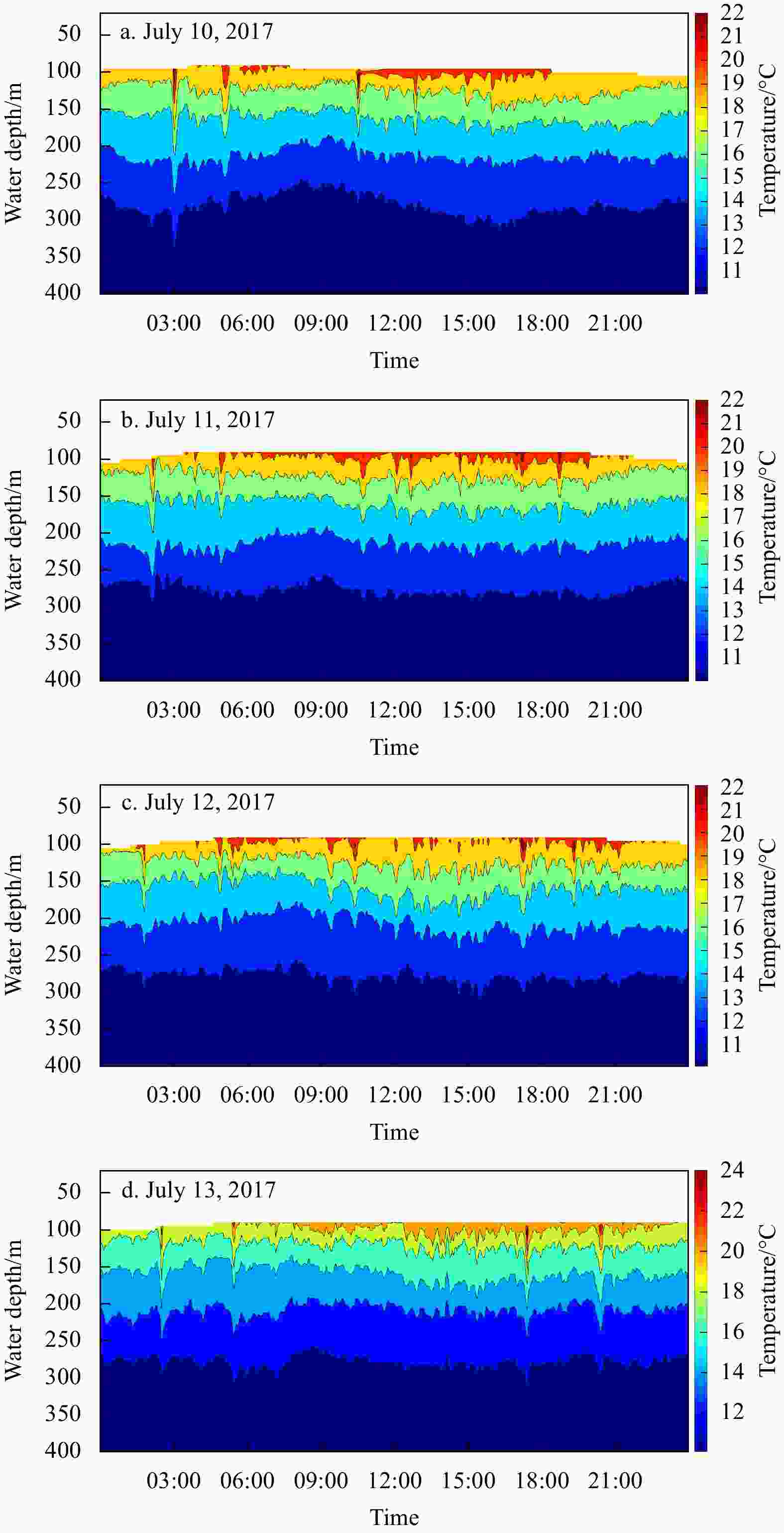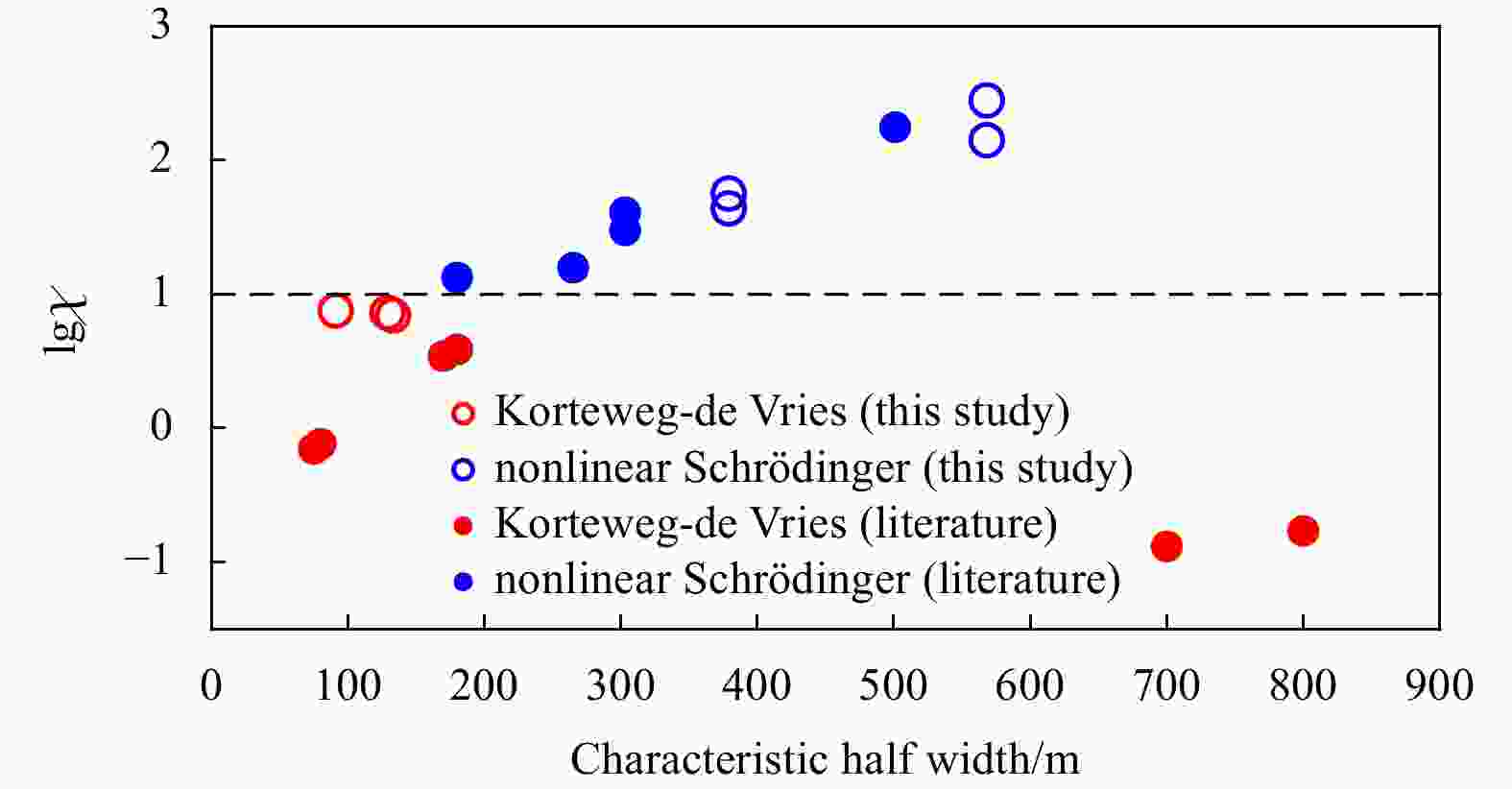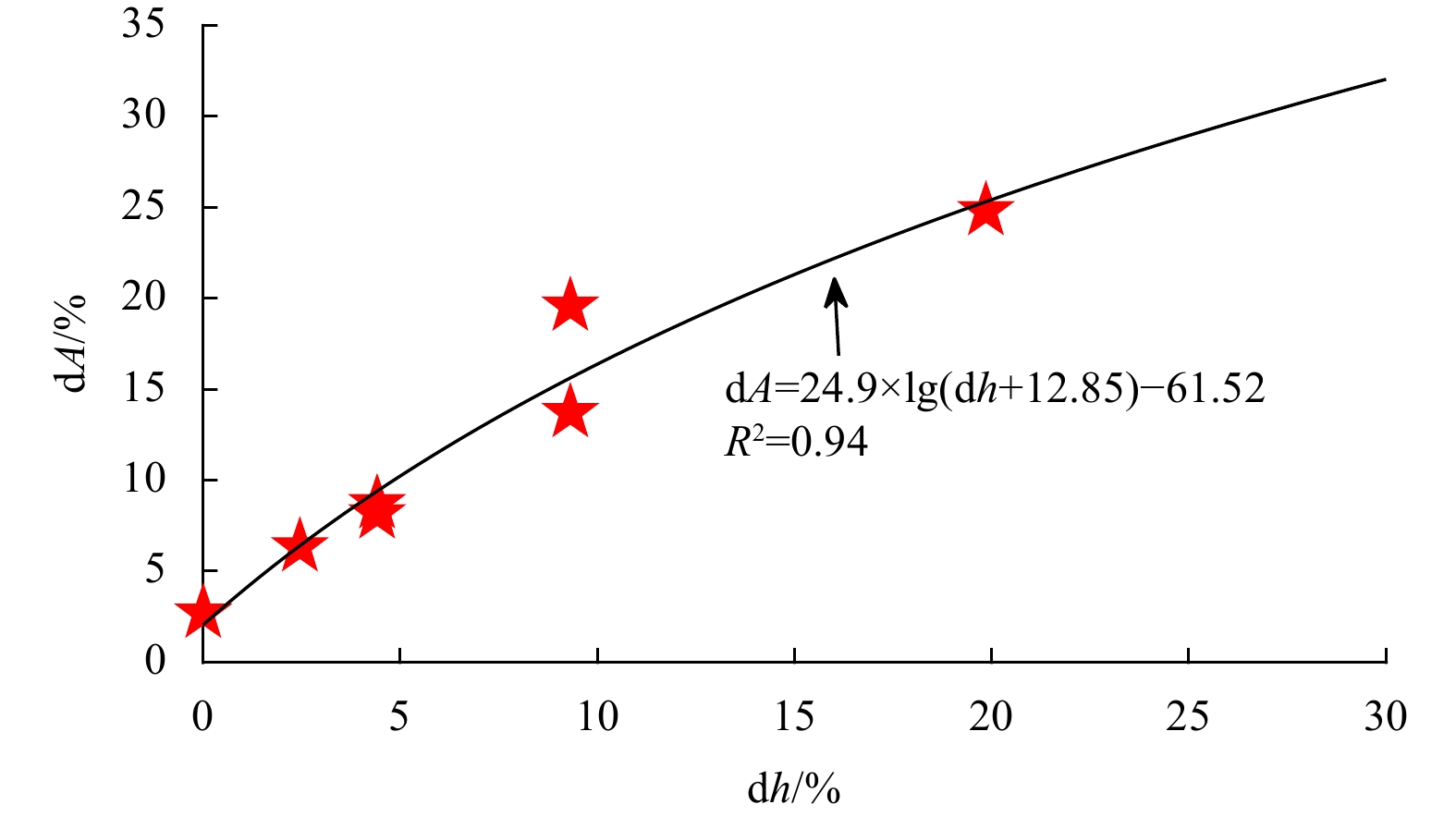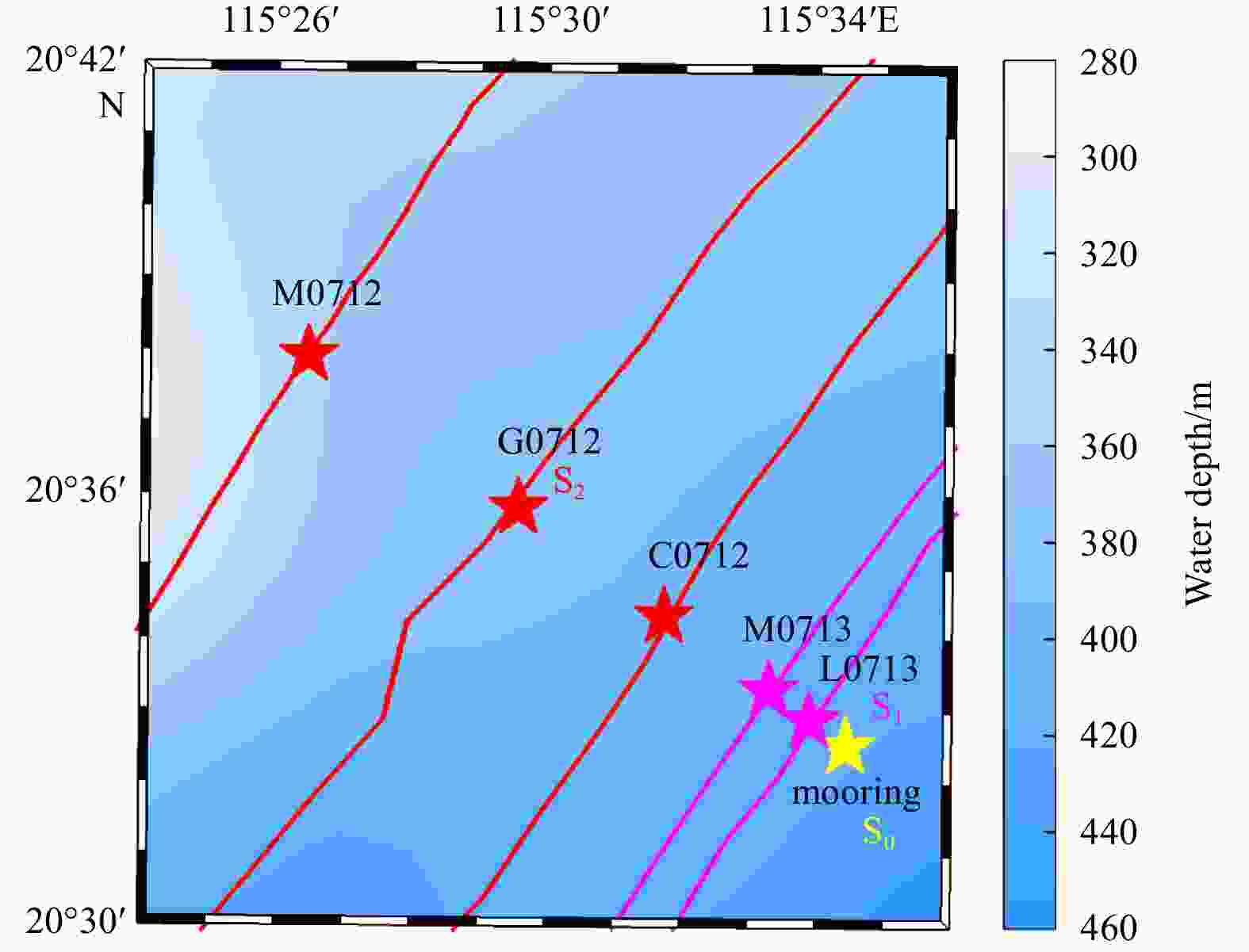Assessment of theoretical approaches to derivation of internal solitary wave parameters from multi-satellite images near the Dongsha Atoll of the South China Sea
-
Abstract: This study assesses the accuracy and the applicability of the Korteweg-de Vries (KdV) and the nonlinear Schrödinger (NLS) equation solutions to derivation of dynamic parameters of internal solitary waves (ISWs) from satellite images. Visible band images taken by five satellite sensors with spatial resolutions from 5 m to 250 m near the Dongsha Atoll of the northern South China Sea (NSCS) are used as a baseline. From the baseline, the amplitudes of ISWs occurring from July 10 to 13, 2017 are estimated by the two approaches and compared with concurrent mooring observations for assessments. Using the ratio of the dimensionless dispersive parameter to the square of dimensionless nonlinear parameter as a criterion, the best appliable ranges of the two approaches are clearly separated. The statistics of total 18 cases indicate that in each 50% of cases, the KdV and the NLS approaches give more accurate estimates of ISW amplitudes. It is found that the relative errors of ISW amplitudes derived from two theoretical approaches are closely associated with the logarithmic bottom slopes. This may be attributed to the nonlinear growth of ISW amplitudes as propagating along a shoaling thermocline or topography. The test results using three consecutive satellite images to retrieve the ISW propagation speeds indicate that the use of multiple satellite images (>2) may improve the accuracy of retrieved phase speeds. Meanwhile, repeated multi-satellite images of ISWs can help to determine the types of ISWs if mooring data are available nearby.
-
Key words:
- internal solitary waves /
- KdV equation /
- NLS equation /
- South China Sea /
- satellite images
-
Figure 1. Satellite images of the internal solitary waves in the northern South China Sea. MODIS images were acquired on July 10 (a), July 11 (b), July 12 (e) and July 13, 2017 (g); CBERS-4 image (c) and GF-1 image (d) were acquired on July 12, 2017; Landsat-7 image (f) was acquired on July 13, 2017.
Figure 7. Locations of the mooring station (yellow pentagram), ISWs observed by CBERS-4/PAN (C0712), GF-1/WFV3 (G0712) and Aqua/MODIS (M0712) (red pentagrams) on July 12, 2017 and Landsat-7/ETM+ (L0713) and Terra/MODIS (M0713) (purple pentagrams) on July 13, 2017. The locations of the mooring station and ISWs observed by Landsat-7/ETM+ on July 13 and GF-1/WFV3 on July 12 are marked as S0, S1 and S2.
Table 1. Information of satellite images
Image No. Image ID Time Satellite (senor) Spatial resolution/m 1 M0710 July 10, 2017, 05:30 UTC Aqua (MODIS) 250 2 M0711 July 11, 2017, 03:10 UTC Terra (MODIS) 250 3 C0712 July 12, 2017, 02:59 UTC CBERS-4 (PAN) 5 4 G0712 July 12, 2017, 03:37 UTC GF-1 (WFV3) 16 5 M0712 July 12, 2017, 05:20 UTC Aqua (MODIS) 250 6 L0713 July 13, 2017, 02:43 UTC Landsat-7 (ETM+) 15 7 M0713 July 13, 2017, 02:55 UTC Terra (MODIS) 250 Table 2. The characteristic parameters of the ISWs observed by satellites and the mooring CTD chain
Image ID Water depth/m l/m Amplitude/m S-KdV S-NLS Mooring M0710 370 500 4.9 55.1 68.5 M0711 390 750 2.3 44.0 48.1 C0712 390 175 42.0 189.6 45.7 G0712 370 176 39.4 158.4 45.7 M0712 327 500 4.3 34.3 45.7 L0713 408 120 67.9 419.5 66.1 M0713 398 750 1.7 61.9 66.1 Note: l is the peak-to-peak distance; S-KdV and S-NLS are amplitudes estimated using the KdV and the NLS equation approaches, respectively; the number in bold represents that the estimated amplitude is closer to the mooring observation. Table 3. ISW amplitudes derived from satellite observations in previous studies
Literature Satellite (sensor) Spatial resolution/m Region Water depth/m l/m Amplitude/m KdV NLS Observation Small et al. (1999) ERS-1 (SAR) 30 Malin Shelf 500 350 24.2 − 49.0 600 400 26.0 − 49.0 700 400 31.7 − 49.0 500 350 49.6 − 30.0 Zheng et al. (2001) ERS-1 (SAR) 30 Portugues Continental Shelf 140 110 26.0 − 23.0 140 220 7.0 − 10.0 140 240 6.0 − 5.0 Radarsat-1 (SAR) 100 SCS 350 900 48.0 − − 350 1100 37.0 − − Li et al. (2008) Envisat (ASAR) 150 SCS 70 99 8.0 − 6.0−10.0 Li et al. (2013) ERS-1 (SAR) 30 Malin Shelf 500 350 − 42.2 49.0 600 400 − 37.8 49.0 700 400 − 40.8 49.0 Huang and Zhao (2014) Aqua (MODIS) 250 SCS 3179 4301 124.0 − 126.0 Zhang et al. (2016) Envisat (ASAR) 150 SCS 92 317 0.7 18.1 18.0 Aqua (MODIS) 250 117 882 − 14.2 15.0 Note: l is the peak-to-peak distance; − represents no data. Table 4. The relative error of satellite estimated ISW amplitude and bottom slope
Image ID Relative error dA/% Bottom slope dh/% M0710 19.5 9.3 M0711 8.7 4.4 C0712 8.1 4.4 G0712 13.7 9.3 M0712 24.8 19.9 L0713 2.7 0 M0713 6.3 2.5 Table 5. Propagation speeds of the ISWs at CBERS-4 and GF-1 locations
Data sources Satellite derived
propagation
speed/(m·s−1)KdV-derived
propagation
speed/(m·s−1)CBERS-4 CBERS-4 and GF-1 2.04 1.62 CBERS-4 and MODIS 1.34 CBERS-4, GF-1 and mooring 1.73 mean 1.70±0.35 GF-1 GF-1 and CBERS-4 2.04 1.58 GF-1 and MODIS 1.08 GF-1, CBERS-4 and MODIS 1.65 mean 1.59±0.48 Table 6. The time that the ISWs passed the locations of the mooring (S0), Landsat-7 (S1) and GF-1 (S2)
Time at S0 Time at S1 Time at S2 July 10, 2017 03:01 04:10 05:27 July 11, 2017 02:08 02:42 04:13 July 12, 2017 01:48 02:17 03:37 July 13, 2017 02:31 02:43 04:19 Note: Time at S0 is mooring measured. The number in italic represents the ISW arrival time at S1 or S2 calculated by the phase speed derived from the KdV equation. The number in bold represents satellite-imaging time. -
[1] Agafontsev D S, Dias F, Kuznetsov E A. 2007. Deep-water internal solitary waves near critical density ratio. Physica D: Nonlinear Phenomena, 225(2): 153–168. doi: 10.1016/j.physd.2006.10.010 [2] Alford M H, Peacock T, MacKinnon J A, et al. 2015. The formation and fate of internal waves in the South China Sea. Nature, 521(7550): 65–69. doi: 10.1038/nature14399 [3] Amante C, Eakins B W. 2009. ETOPO1 arc-minute global relief model: procedures, data sources and analysis. In: NOAA Technical Memorandum NESDIS NGDC-24. https://repository.library.noaa.gov/view/noaa/1163https://repository.library.noaa.gov/view/noaa/1163[2019-03-05/2020-12-26] [4] Chang Ming-Huei, Lien Ren-Chieh, Tang Tswen Yung, et al. 2006. Energy flux of nonlinear internal waves in northern South China Sea. Geophysical Research Letters, 33(3): L03607 [5] Chen Liang, Zheng Quanan, Xiong Xuejun, et al. 2018. A new type of internal solitary waves with a re-appearance period of 23 h observed in the South China Sea. Acta Oceanologica Sinica, 37(9): 116–118. doi: 10.1007/s13131-018-1252-y [6] Chin T M, Vazquez-Cuervo J, Armstrong E M. 2017. A multi-scale high-resolution analysis of global sea surface temperature. Remote Sensing of Environment, 200: 154–169. doi: 10.1016/j.rse.2017.07.029 [7] Dai Dejun, Wang Wei, Zhang Qinghua, et al. 2011. Eigen solutions of internal waves over subcritical topography. Acta Oceanologica Sinica, 30(2): 1–8. doi: 10.1007/s13131-011-0099-2 [8] Dong Di, Yang Xiaofeng, Li Xiaofeng, et al. 2016. SAR observation of eddy-induced mode-2 internal solitary waves in the South China Sea. IEEE Transactions on Geoscience and Remote Sensing, 54(11): 6674–6686. doi: 10.1109/TGRS.2016.2587752 [9] Geng Minghui, Song Haibin, Guan Yongxian, et al. 2019. Analyzing amplitudes of internal solitary waves in the northern South China Sea by use of seismic oceanography data. Deep-Sea Research Part I: Oceanographic Research Papers, 146: 1–10. doi: 10.1016/j.dsr.2019.02.005 [10] Guo Chuncheng, Chen Xueen. 2014. A review of internal solitary wave dynamics in the northern South China Sea. Progress in Oceanography, 121: 7–23. doi: 10.1016/j.pocean.2013.04.002 [11] Helfrich K R, Melville W K. 2006. Long nonlinear internal waves. Annual Review of Fluid Mechanics, 38: 395–425. doi: 10.1146/annurev.fluid.38.050304.092129 [12] Hsu M K, Liu A K. 2000. Nonlinear internal waves in the South China Sea. Canadian Journal of Remote Sensing, 26(2): 72–81. doi: 10.1080/07038992.2000.10874757 [13] Huang Xiaodong, Chen Zhaohui, Zhao Wei, et al. 2016. An extreme internal solitary wave event observed in the northern South China Sea. Scientific Reports, 6(1): 30041. doi: 10.1038/srep30041 [14] Huang Xiaodong, Zhao Wei. 2014. Information of internal solitary wave extracted from MODIS image: a case in the deep water of northern South China Sea. Periodical of Ocean University of China, 44(7): 19–23 [15] Jackson C. 2007. Internal wave detection using the Moderate Resolution Imaging Spectroradiometer (MODIS). Journal of Geophysical Research: Oceans, 112(C11): C11012. doi: 10.1029/2007JC004220 [16] Jia Tong, Liang Jianjun, Li Xiaoming, et al. 2019. Retrieval of internal solitary wave amplitude in shallow water by tandem spaceborne SAR. Remote Sensing, 11(14): 1706. doi: 10.3390/rs11141706 [17] Lee C Y, Beardsley R C. 1974. The generation of long nonlinear internal waves in a weakly stratified shear flow. Journal of Geophysical Research, 79(3): 453–462. doi: 10.1029/JC079i003p00453 [18] Lellouche J M, Le Galloudec O, Greiner E, et al. 2018. The Copernicus Marine Environment Monitoring Service global ocean 1/12° physical reanalysis GLORYS12V1: description and quality assessment. In: Proceedings of the Geophysical Research Abstracts, Vol. 20. Vienna, Austria: EGU [19] Li Xiaoyong, Wang Jing, Sun Meiling, et al. 2013. Internal wave parameter inversion at Malin Shelf edge based on the nonlinear Schrödinger equation. Applied Mechanics and Materials, 441: 388–392. doi: 10.4028/www.scientific.net/AMM.441.388 [20] Li Xiaofeng, Zhao Zhongxiang, Han Zhen, et al. 2008. Internal solitary waves in the East China Sea. Acta Oceanologica Sinica, 27(3): 51–59 [21] Liu Bingqing, Yang Hong, Zhao Zhongxiang, et al. 2014. Internal solitary wave propagation observed by tandem satellites. Geophysical Research Letters, 41(6): 2077–2085. doi: 10.1002/2014GL059281 [22] O'Driscoll K, Levine M. 2017. Simulations and observation of nonlinear internal waves on the continental shelf: Korteweg-de Vries and extended Korteweg-de Vries solutions. Ocean Science, 13(5): 749–763. doi: 10.5194/os-13-749-2017 [23] Osborne A R, Burch T L. 1980. Internal solitons in the Andaman Sea. Science, 208(4443): 451–460. doi: 10.1126/science.208.4443.451 [24] Ostrovsky L A, Stepanyants Y A. 1989. Do internal solitions exist in the ocean. Reviews of Geophysics, 27(3): 293–310. doi: 10.1029/RG027i003p00293 [25] Pelinovsky D. 1995. Intermediate nonlinear Schrödinger equation for internal waves in a fluid of finite depth. Physics Letters A, 197(5–6): 401–406. doi: 10.1016/0375-9601(94)00991-W [26] Ramp S R, Tang Tswen Yung, Duda T F, et al. 2004. Internal solitons in the northeastern South China Sea. Part I: Sources and deep water propagation. IEEE Journal of Oceanic Engineering, 29(4): 1157–1181. doi: 10.1109/JOE.2004.840839 [27] Ramp S R, Yang Y J, Bahr F L. 2010. Characterizing the nonlinear internal wave climate in the northeastern South China Sea. Nonlinear Processes in Geophysics, 17(5): 481–498. doi: 10.5194/npg-17-481-2010 [28] Small J, Hallock Z, Pavey G, et al. 1999. Observations of large amplitude internal waves at the Malin Shelf edge during SESAME 1995. Continental Shelf Research, 19(11): 1389–1436. doi: 10.1016/S0278-4343(99)00023-0 [29] Stanton T P, Ostrovsky L A. 1998. Observations of highly nonlinear internal solitons over the continental shelf. Geophysical Research Letters, 25(14): 2695–2698. doi: 10.1029/98GL01772 [30] Wang Jing, Guo Kai, Meng Junmin. 2012. Study of the propagation model for large-amplitude internal waves in deep sea. Chinese Journal of Lasers, 39(S2): S214004 [31] Wang Juan, Huang Weigen, Yang Jingsong, et al. 2013. Study of the propagation direction of the internal waves in the South China Sea using satellite images. Acta Oceanologica Sinica, 32(5): 42–50. doi: 10.1007/s13131-013-0312-6 [32] Xie Jieshuo, He Yinghui, Cai Shuqun. 2019. Bumpy topographic effects on the transbasin evolution of large-amplitude internal solitary wave in the northern South China Sea. Journal of Geophysical Research: Oceans, 124(7): 4677–4695. doi: 10.1029/2018JC014837 [33] Xie Jieshuo, He Yinghui, Lü Haibin, et al. 2016. Distortion and broadening of internal solitary wavefront in the northeastern South China Sea deep basin. Geophysical Research Letters, 43(14): 7617–7624. doi: 10.1002/2016GL070093 [34] Xu Zhaoting, Lou Shunli, Tian Jiwei, et al. 1996. NLS equation of internal waves in weakly stratified ocean. Chinese Journal of Oceanology and Limnology, 14(2): 121–127. doi: 10.1007/BF02850368 [35] Xu Qing, Zheng Quan’an, Lin Hui, et al. 2008. Dynamical analysis of mesoscale eddy—induced ocean internal waves using linear theories. Acta Oceanologica Sinica, 27(3): 60–69 [36] Xue Jingshuang, Graber H C, Lund B, et al. 2013. Amplitudes estimation of large internal solitary waves in the mid-Atlantic bight using synthetic aperture radar and marine X-band radar images. IEEE Transactions on Geoscience and Remote Sensing, 51(6): 3250–3258. doi: 10.1109/TGRS.2012.2221467 [37] Yang Jingsong, Huang Weigen, Zhou Chenghu, et al. 2003. The International Society for Optical Engineering. Proceedings of SPIE, 4892: 450–454. doi: 10.1117/12.466772 [38] Zhang Xudong, Wang Jing, Sun Lina, et al. 2016. Study on the amplitude inversion of internal waves at Wenchang area of the South China Sea. Acta Oceanologica Sinica, 35(7): 14–19. doi: 10.1007/s13131-016-0902-1 [39] Zhao Zhongxiang, Klemas V, Zheng Quanan, et al. 2004. Remote sensing evidence for baroclinic tide origin of internal solitary waves in the northeastern South China Sea. Geophysical Research Letters, 31(6): L06302 [40] Zhao Zhongxiang, Liu Bingqing, Li Xiaofeng. 2014. Internal solitary waves in the China seas observed using satellite remote-sensing techniques: a review and perspectives. International Journal of Remote Sensing, 35(11–12): 3926–3946. doi: 10.1080/01431161.2014.916442 [41] Zheng Quanan. 2017. Satellite SAR Detection of Sub-Mesoscale Ocean Dynamic Processes. London: World Scientific, 121–178 [42] Zheng Quanan, Song Y T, Lin Hui, et al. 2008. On generation source sites of internal waves in the Luzon Strait. Acta Oceanologica Sinica, 27(3): 38–50 [43] Zheng Quanan, Susanto R D, Ho C R, et al. 2007. Statistical and dynamical analyses of generation mechanisms of solitary internal waves in the northern South China Sea. Journal of Geophysical Research: Oceans, 112(C3): C03021 [44] Zheng Quanan, Xie Lingling, Xiong Xuejun, et al. 2020. Progress in research of submesoscale processes in the South China Sea. Acta Oceanologica Sinica, 39(1): 1–13. doi: 10.1007/s13131-019-1521-4 [45] Zheng Quanan, Yuan Yeli, Klemas V, et al. 2001. Theoretical expression for an ocean internal soliton synthetic aperture radar image and determination of the soliton characteristic half width. Journal of Geophysical Research: Oceans, 106(C12): 31415–31423. doi: 10.1029/2000JC000726 -




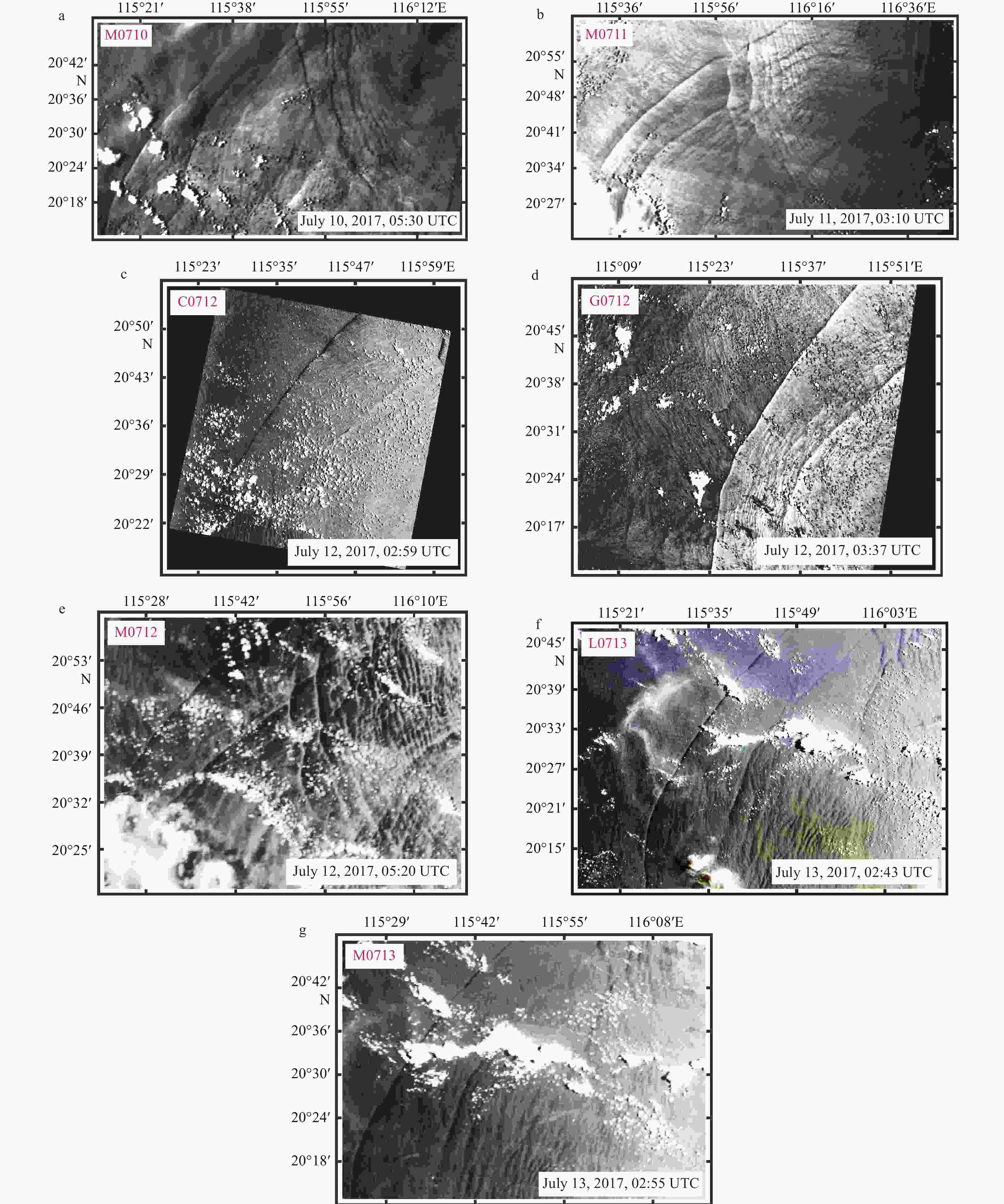
 下载:
下载:

